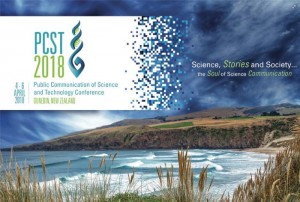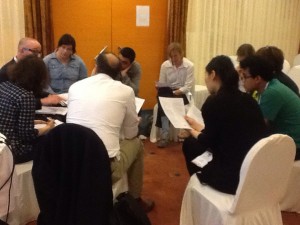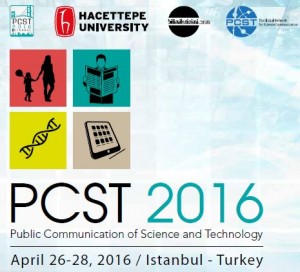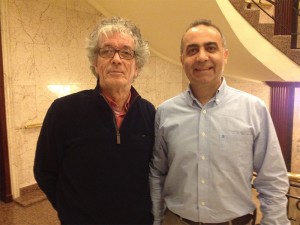I’ve just returned from the Public Communication of Science and Technology (PCST) Conference in Istanbul, Turkey. It was, in almost every sense of the term, a most extraordinary event, organised with courage, solidarity and warm hospitality in the face of a devastating refugee crisis and political unrest.
The spirit of the conference was captured beautifully by the PCST President Brian Trench at the start of the event. “Let’s talk, let’s laugh, let’s listen”, and we did.
If you haven’t seen Brian’s opening address, you can find the text here (Opening Address).
And if you think this is for you, start saving your [insert name of currency here] and come along to the 15th International PCST Conference in April 2018.
The PCST community will meet again at the University of Otago in Dunedin, New Zealand; #hugahobbit
Discipline versus community
This was my eighth conference. At each event I’d argue that the overall quality of the contributions has improved. More importantly, the quality of the discussions and debates around these contributions was extremely stimulating.
We could argue, and we have argued (e.g. see Jcom ‘Roadmaps’ Commentaries), about whether science communication is a distinct discipline. That question will continue to be debated, but that’s for another time. (And for the record I’m not arguing that the two are mutually exclusive.)
I’d argue that what we have when we come together at PCST events is something far more important than discussions about (trans)national academic boundaries (Schumner, 2009). What we have is a community, a genuinely international community that is willing to cross national, cultural, conceptual and professional borders to explore difficult, sometimes challenging, but always important issues.
The nature of our community was evident to me in the quality of our discussions. Researchers from a range of disciplines shared ground in Istanbul to consider theoretical perspectives and empirical findings.
Practitioners shared the types of localised, contextual, experiential knowledge that many of us value in the publics, stakeholders and end-users that we communicate to, and engage with.
And the third stream professionals (Whitchurch, 2008) among us stood astride borders, negotiating the sometimes contested spaces between us.
As Glen Aitkenhead (e.g. 1996) showed so eloquently and pragmatically through his science education research and practices in Canada, crossing borders can be challenging. Borders, in particular cultural ones, are not always easy to identify. The collaborations we often hope to pursue as a result, can also be disruptive and unnerving. And the potential for conflict and confusion abounds while consensus is rarely, if ever, complete.
Given this challenging context, I’d argue that for genuine engagement to take place, we have to be willing to be generous and to lose arguments along the way. Regardless of how knowledgeable we might think we are, we should never expect not to get everything we want.
Collectively, I felt a tangible sense at the conference that we are gaining confidence that we have shared understandings of the challenges we face. This is an extraordinary accomplishment given the diverse cultures that are participating. These shared understandings are hard won; gaining them requires humility and a commitment to pluralism. None of us can know everything; together, we are more than the sum of our parts and we might just have a fighting chance to make science communication and engagement work for the communities we value and who value us.
Crucially, we also need to move beyond collective understandings and towards engagement. As a community, we are generating and sharing evidence to demonstrate how to intervene in particular contexts, and how to reflect on the relative success of those interventions. In this context, it was gratifying to see that the emergence of blended ‘third stream’ professionals is also apparent in other nations and cultures (Whitchurch, 2008).
These “boundary creatures inhabit more than one world” (McGinnis, 1998, p. 61), acting in the role of professional facilitators as we engage across borders (adapted from Aitkenhead, 1996). Their skills in mediation are becoming increasingly important, and I hope recognised (Holliman, 2015). When successful they can engineer solutions that work for all parties to engagement processes and activities.
As an international community, I see this as our major challenge going forwards. To paraphrase Karl Marx (and no, I’m not suggesting that we all need to become Marxists), our shared vision should not just be to interpret the world of science communication and engagement. It should also be to change it in ways that are mutually beneficial to as many of the participants as possible.
The need for continued border crossings
I’ve recently completed a culture change project at the Open University (Holliman, et al. 2015). Our aim, alongside seven other universities, was to embed the practices of engagement within our research cultures (RCUK, 2016).
My role on this project required numerous, in fact almost constant, border crossings as I moved from discipline to discipline, from postgraduate research to professor, from engagement practitioner to policy maker, from funder to funder, and from university to university. Much of my time was spent identifying borders, and navigating through them to seek shared territory where we could work productively.
Each intervention, each conversation, each negotiation required the various participants to those processes, including me, to make their thinking visible before we could attempt to move forwards to the next stage. This requires sophisticated communication skills allied with skills in engagement; the two sets of skills overlap to some degree. I’d argue that both are necessary to be an effective engagement practitioner or researcher (Holliman, 2016).
The skills and competencies I had gained from participating in PCST Conferences and events were extremely valuable to enable these border crossings. Engaging with colleagues in the PCST community has provided me with a metaphorical passport, and sometimes with visas when these were necessary. (I always knew I had an extra challenge when I needed a metaphorical visa.) I’m delighted to be among friends when I argue that we must cherish and foster this community so that it continues to grow and support future generations of science communicators.
My final word has to go to the organisers on PCST 2016. Wherever you are in the world, if you care about science communication and engagement raise a glass to Gultekin Cakmakci, Brian Trench and the PCST Committee. Like so many others I owe them a great debt of gratitude for making PCST 2016 possible. We are greater for having talked, laughed and listened across borders. Thank you.
References
Aitkenhead, G. (1996). Toward a First Nations cross-cultural science and technology curriculum. Culture and Comparative Studies, 81, pp. 217-38.
Holliman, R. (2016). Supporting researchers in public engagement: Is engagement good for your career? Engaging Research Blog, 3 May. Available from: https://www.open.ac.uk/blogs/per/?p=6872
Holliman, R., Adams, A., Blackman, T., Collins, T., Davies, G., Dibb, S., Grand, A., Holti, R., McKerlie, F., Mahony, N. and Wissenburg, A. (2015). An Open Research University: Final Report. The Open University: Milton Keynes. Available from: http://oro.open.ac.uk/44255
Holliman, R. (2015). Valuing engaged research. Euroscientist Webzine,
4 November. Available from: http://www.euroscientist.com/valuing-publicly-engaged-research
McGinnis, M. (Ed.). (1998). Bioregionalism. Taylor and Francis.
Research Councils UK (RCUK) (2016). Public Engagement with Research Catalysts Final Reports. RCUK: Swindon. Available from: http://www.rcuk.ac.uk/pe/catalysts/reports
Schumner, J. (2009). Science communication across disciplines. In: Holliman, R. Thomas, J., Smidt, S., Scanlon, E. and Whitelegg, E. (eds) Practising science communication in the information age: Theorising professional practices (pp. 53-66). Oxford University Press: Oxford.
Whitchurch, C. (2008). Shifting identities and blurring boundaries: the emergence of Third Space professionals in UK higher education. Higher Education Quarterly, 62(4). pp. 377-96. Available from: http://eprints.ioe.ac.uk/2035
Acknowledgements
All my expenses for attending the conference were covered by the School of Environment, Earth and Ecosystems at the Open University, UK. They’re also a great community to belong to. But’s that’s for another day and another blog post.






Your contributions to PCST conferences have been consistent and high-quality. We are lucky to have supporters like you.
Dear Rick, thank you for this great commentary on the PCST meeting in Istanbul. You have really captured the essence and challenges of “crossing borders” in our field very well.